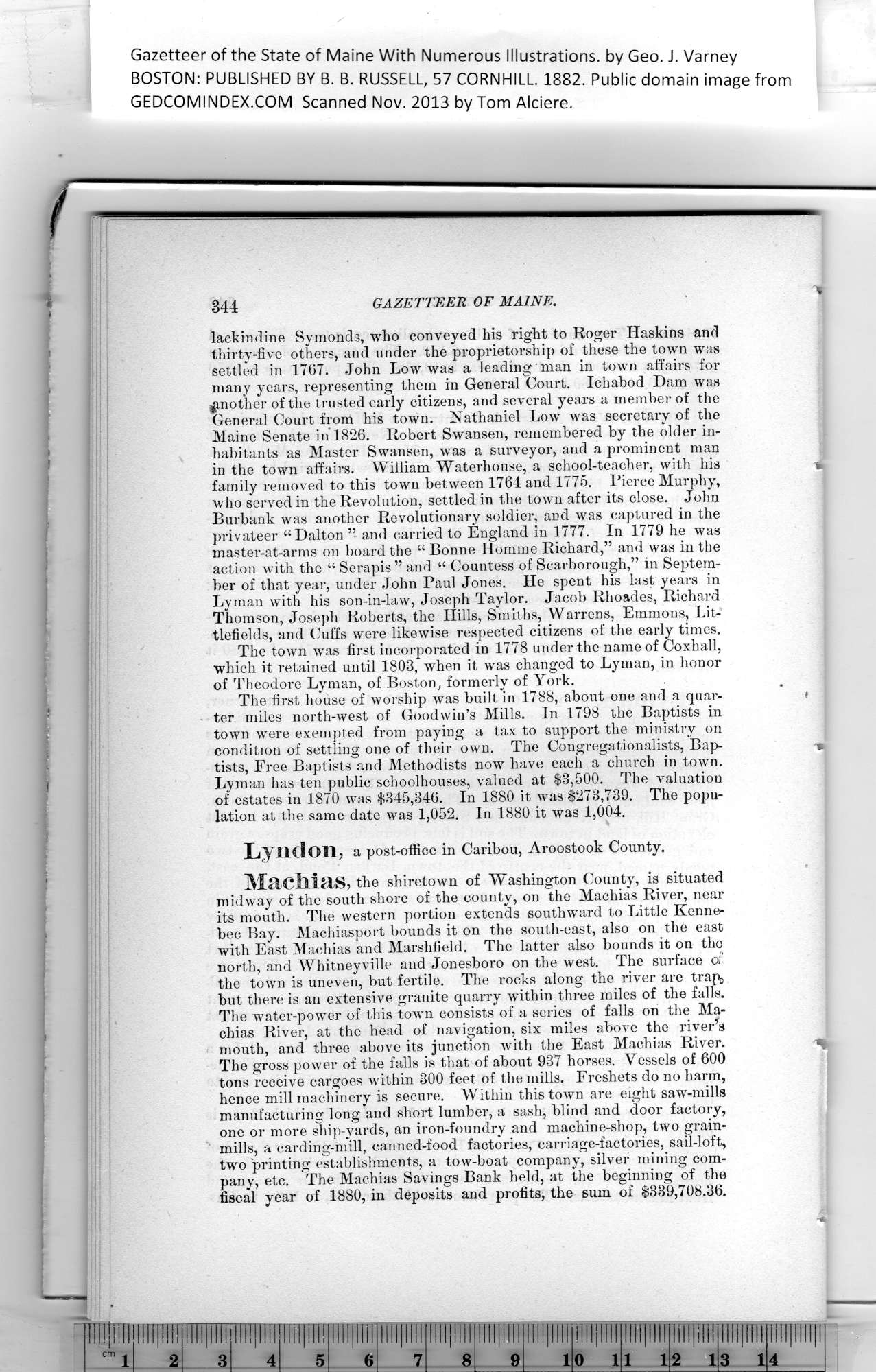|
Gazetteer of the State of Maine With Numerous Illustrations, by Geo. J. Varney
BOSTON. PUBLISHED BY B. B. RUSSELL, 57 CORNHILL. 1882. Public domain image from
344 GAZETTEER OF MAINE.
lackindine Symonds, wTio conveyed his right to Roger Haskins and
thirty-five others, and under the proprietorship of these the town was
settled in 1767. John Low was a leading man in town affairs for
many years, representing them in General Court. Ichabod Dam was
^mother of the trusted early citizens, and several years a member of the
General Court from his town. Nathaniel Low was secretary of the
Maine Senate in‘1826. Robert Swansen, remembered by the older in-
habitants as Master Swansen, was a surveyor, and a prominent man
in the town affairs. William Waterhouse, a school-teacher, with his
family removed to this town between 1764 and 1775. Pierce Murphy,
who served in the Revolution, settled in the town after its close. John
Burbank was another Revolutionary soldier, and was captured in the
privateer “Dalton ” and carried to England in 1777. In 1779 he was
master-at-arms on board tbe “ Bonne Homme Richard,” and was in tbe
action with the “ Serapis ” and “ Countess of Scarborough,” in Septem-
ber of that year, under John Paul Jones. He spent his last years in
Lyman with his son-in-law, Joseph Taylor. Jacob Rhoades, Richard
Thomson, Joseph Roberts, the Hills, Smiths, Warrens, Emmons, Lit-
tlefields, and Cuffs were likewise respected citizens of the early times.
The town was first incorporated in 1778 under tbe name of Coxhall,
which it retained until 1803, when it was changed to Lyman, in honor
of Theodore Lyman, of Boston, formerly of York.
The first house of worship was built in 1788, about one and a quar- t
ter miles north-west of Goodwin’s Mills. In 1798 the Baptists in
town were exempted from paying a tax to support the ministry on
condition of settling one of their own. The Congregationalists, Bap-
tists, Free Baptists and Methodists now have each a church in town.
Lyman has ten public schoolhouses, valued at $3,500. The valuation
of estates in 1870 was $345,346. In 1880 it was $273,739. The popu-
lation at the same date was 1,052. In 1880 it was 1,004.
Lyndon, a post-office in Caribou, Aroostook County.
Machias, the shiretown of Washington County, is situated
midway of the south shore of the county, on the Machias River, near
its mouth. The western portion extends southward to Little Kenne-
bec Bay. Machiasport bounds it on the south-east, also on the east
with East Machias and Marshfield. The latter also bounds it on the
north, and Whitneyville and Jonesboro on the west. The surface of
the town is uneven, but fertile. The rocks along the river are trap,
but there is an extensive granite quarry within three miles of the falls.
The water-power of this town consists of a series of falls on the Ma-
chias River, at the head of navigation, six miles above the river’s
mouth, and three above its junction with the East Macbias River.
The gross power of the falls is that of about 937 horses. Vessels of 600
tons receive cargoes within 300 feet of the mills. Freshets do no harm,
hence mill machinery is secure. Within this town are eight saw-mills
manufacturing long and short lumber, a sash, blind and door factory,
one or more ship-yards, an iron-foundry and machine-shop, two grain-
mills, a carding-mill, canned-food factories, carriage-factories, sail-loft,
two printing establishments, a tow-boat company, silver mining com-
pany, etc. The Machias Savings Bank held, at the beginning of the
fiscal year of 1880, in deposits and profits, the sum of $339,708.36.
PREVIOUS PAGE ... NEXT PAGE
This page was written in HTML using a program written in Python 3.2
|
